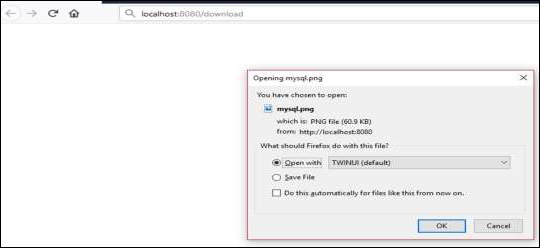В этой главе вы узнаете, как загрузить и загрузить файл с помощью веб-службы.
Файл загружен
Для загрузки файла вы можете использовать MultipartFile в качестве параметра запроса, и этот API должен использовать значение данных формы из нескольких частей. Соблюдайте код, указанный ниже —
@RequestMapping(value = "/upload", method = RequestMethod.POST, consumes = MediaType.MULTIPART_FORM_DATA_VALUE) public String fileUpload(@RequestParam("file") MultipartFile file) { return null; }
Полный код для того же приведен ниже —
package com.tutorialspoint.demo.controller; import java.io.File; import java.io.FileOutputStream; import java.io.IOException; import org.springframework.http.MediaType; import org.springframework.web.bind.annotation.RequestMapping; import org.springframework.web.bind.annotation.RequestMethod; import org.springframework.web.bind.annotation.RequestParam; import org.springframework.web.bind.annotation.RestController; import org.springframework.web.multipart.MultipartFile; @RestController public class FileUploadController { @RequestMapping(value = "/upload", method = RequestMethod.POST, consumes = MediaType.MULTIPART_FORM_DATA_VALUE) public String fileUpload(@RequestParam("file") MultipartFile file) throws IOException { File convertFile = new File("/var/tmp/"+file.getOriginalFilename()); convertFile.createNewFile(); FileOutputStream fout = new FileOutputStream(convertFile); fout.write(file.getBytes()); fout.close(); return "File is upload successfully"; } }
Скачать файл
Для загрузки файла вы должны использовать InputStreamResource для загрузки файла. Нам нужно установить HttpHeader Content-Disposition в Response и указать тип Media в ответе приложения.
Примечание. В следующем примере файл должен быть доступен по указанному пути, где выполняется приложение.
@RequestMapping(value = "/download", method = RequestMethod.GET) public ResponseEntity<Object> downloadFile() throws IOException { String filename = "/var/tmp/mysql.png"; File file = new File(filename); InputStreamResource resource = new InputStreamResource(new FileInputStream(file)); HttpHeaders headers = new HttpHeaders(); headers.add("Content-Disposition", String.format("attachment; filename=\"%s\"", file.getName())); headers.add("Cache-Control", "no-cache, no-store, must-revalidate"); headers.add("Pragma", "no-cache"); headers.add("Expires", "0"); ResponseEntity<Object> responseEntity = ResponseEntity.ok().headers(headers).contentLength(file.length()).contentType( MediaType.parseMediaType("application/txt")).body(resource); return responseEntity; }
Полный код для того же приведен ниже —
package com.tutorialspoint.demo.controller; import java.io.File; import java.io.FileInputStream; import java.io.IOException; import org.springframework.core.io.InputStreamResource; import org.springframework.http.HttpHeaders; import org.springframework.http.MediaType; import org.springframework.http.ResponseEntity; import org.springframework.web.bind.annotation.RequestMapping; import org.springframework.web.bind.annotation.RequestMethod; import org.springframework.web.bind.annotation.RestController; @RestController public class FileDownloadController { @RequestMapping(value = "/download", method = RequestMethod.GET) public ResponseEntity<Object> downloadFile() throws IOException { String filename = "/var/tmp/mysql.png"; File file = new File(filename); InputStreamResource resource = new InputStreamResource(new FileInputStream(file)); HttpHeaders headers = new HttpHeaders(); headers.add("Content-Disposition", String.format("attachment; filename=\"%s\"", file.getName())); headers.add("Cache-Control", "no-cache, no-store, must-revalidate"); headers.add("Pragma", "no-cache"); headers.add("Expires", "0"); ResponseEntity<Object> responseEntity = ResponseEntity.ok().headers(headers).contentLength( file.length()).contentType(MediaType.parseMediaType("application/txt")).body(resource); return responseEntity; } }
Основное приложение Spring Boot приведено ниже —
package com.tutorialspoint.demo; import org.springframework.boot.SpringApplication; import org.springframework.boot.autoconfigure.SpringBootApplication; @SpringBootApplication public class DemoApplication { public static void main(String[] args) { SpringApplication.run(DemoApplication.class, args); } }
Код для сборки Maven — pom.xml приведен ниже —
<?xml version = "1.0" encoding = "UTF-8"?> <project xmlns = "http://maven.apache.org/POM/4.0.0" xmlns:xsi = "http://www.w3.org/2001/XMLSchema-instance" xsi:schemaLocation = "http://maven.apache.org/POM/4.0.0 http://maven.apache.org/xsd/maven-4.0.0.xsd"> <modelVersion>4.0.0</modelVersion> <groupId>com.tutorialspoint</groupId> <artifactId>demo</artifactId> <version>0.0.1-SNAPSHOT</version> <packaging>jar</packaging> <name>demo</name> <description>Demo project for Spring Boot</description> <parent> <groupId>org.springframework.boot</groupId> <artifactId>spring-boot-starter-parent</artifactId> <version>1.5.8.RELEASE</version> <relativePath/> </parent> <properties> <project.build.sourceEncoding>UTF-8</project.build.sourceEncoding> <project.reporting.outputEncoding>UTF-8</project.reporting.outputEncoding> <java.version>1.8</java.version> </properties> <dependencies> <dependency> <groupId>org.springframework.boot</groupId> <artifactId>spring-boot-starter-web</artifactId> </dependency> <dependency> <groupId>org.springframework.boot</groupId> <artifactId>spring-boot-starter-test</artifactId> <scope>test</scope> </dependency> </dependencies> <build> <plugins> <plugin> <groupId>org.springframework.boot</groupId> <artifactId>spring-boot-maven-plugin</artifactId> </plugin> </plugins> </build> </project>
Код для Gradle Build — build.gradle приведен ниже —
buildscript {
ext {
springBootVersion = '1.5.8.RELEASE'
}
repositories {
mavenCentral()
}
dependencies {
classpath("org.springframework.boot:spring-boot-gradle-plugin:${springBootVersion}")
}
}
apply plugin: 'java'
apply plugin: 'eclipse'
apply plugin: 'org.springframework.boot'
group = 'com.tutorialspoint'
version = '0.0.1-SNAPSHOT'
sourceCompatibility = 1.8
repositories {
mavenCentral()
}
dependencies {
compile('org.springframework.boot:spring-boot-starter-web')
testCompile('org.springframework.boot:spring-boot-starter-test')
}
Теперь вы можете создать исполняемый файл JAR и запустить приложение Spring Boot, используя команды Maven или Gradle, приведенные ниже —
Для Maven используйте команду, приведенную ниже —
mvn clean install
После «BUILD SUCCESS» вы можете найти файл JAR в целевой директории.
Для Gradle вы можете использовать команду, показанную ниже —
sgradle clean build
После «BUILD SUCCESSFUL» вы можете найти файл JAR в каталоге build / libs.
Теперь запустите файл JAR с помощью следующей команды —
java –jar <JARFILE>
Это запустит приложение на порт Tomcat 8080, как показано ниже —
Теперь нажмите на URL-адреса ниже в приложении POSTMAN, и вы можете увидеть результат, как показано ниже —
Загрузка файла — http: // localhost: 8080 / upload
Загрузка файла — http: // localhost: 8080 / upload

